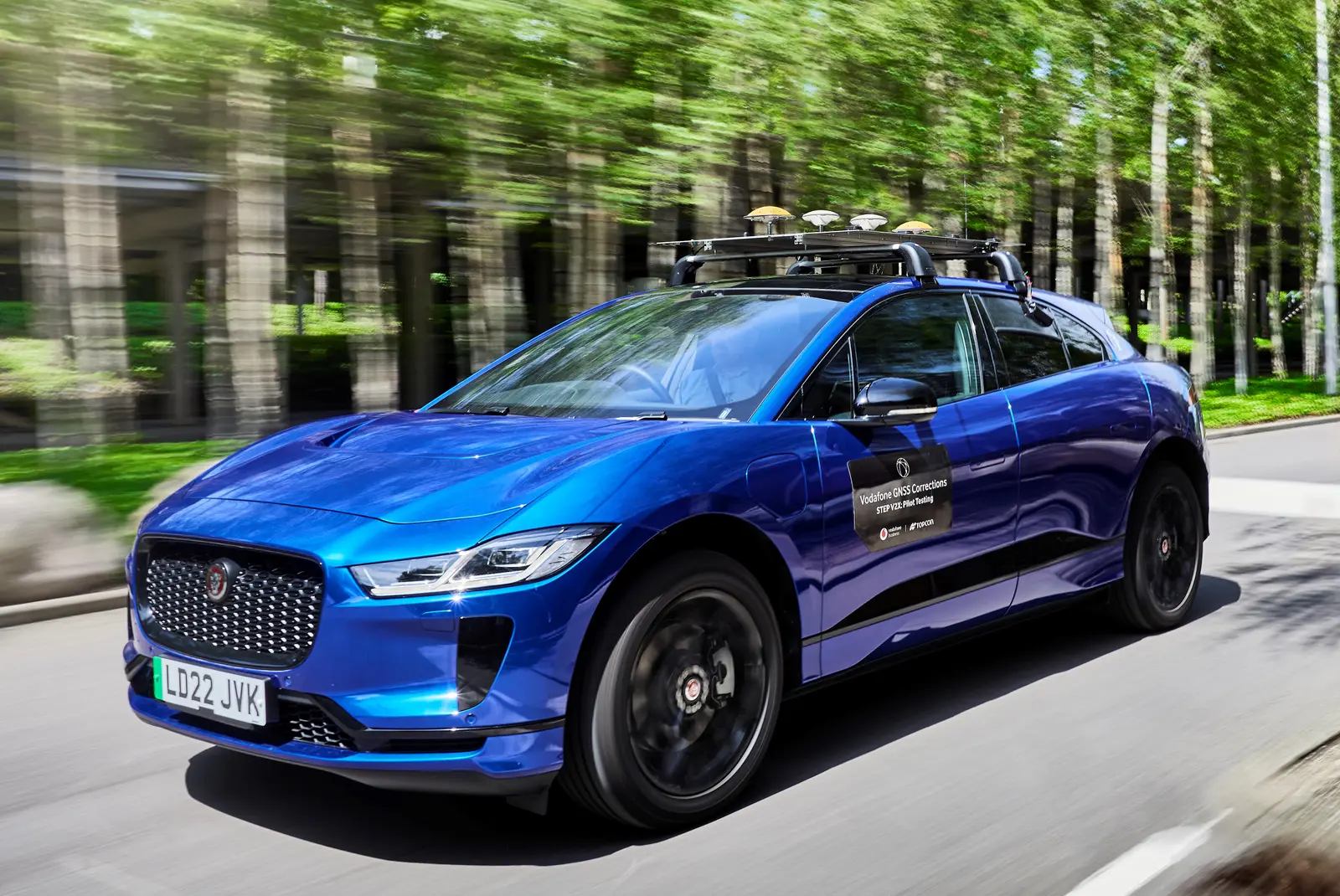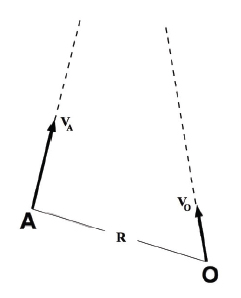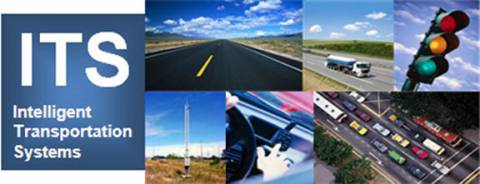Topcon and Vodafone have partnered to develop a GNSS positioning service that will enable C-V2X and emerging intelligent transportation systems.
Topcon Positioning Group is known for delivering high precision GNSS correction services to various markets, including construction and agriculture, with its Topnet Live service. Now, through a partnership with Vodafone, the company will leverage its corrections expertise to develop a mass-market positioning system to locate Internet of Things (IoT) devices, machinery and vehicles with more accuracy than “stand alone” GNSS.
The service, called Vodafone GNSS Corrections, will make it possible to securely position vehicles, scooters, robot lawn mowers and other devices connected to Vodafone’s global IoT network in real time. Using Topcon’s European network, which consists of thousands of GNSS reference stations, the service will improve location accuracy from a few meters to within centimeters when the appropriate receivers and antennas are used.
“Vodafone has the infrastructure, capability and experience to broadcast IoT services to mass market applications,” Vice President of Topcon Global Emerging Business Ian Stilgoe said. “Topcon’s expertise is in GNSS precise positioning and managing GNSS correction network services. By partnering, we bring together this expertise to provide a service to a broader market. We are also in a strong position to influence the technology developments to standardize future services.”
Rolling out the service
The companies are conducting advance customer trials to support vehicle to everything (V2X) testing, with Vodafone now inviting select customers to participate in pilot activities in Germany, Spain, UK and Ireland. OEMs will have the opportunity to test the service by connecting a variety of receivers to Vodafone’s network, which has more than 150 million connected IoT devices.
While the focus for now is Vodafone OEMs, other customers can join the new Safer Transport for Europe Platform (STEP) trials.
Stilgoe couldn’t name any specific customers involved in the trials, but he did say automotive companies and chipset manufacturers were among them.
“Vodafone’s IoT business includes the Automotive group for connected car services, including in vehicle telematics,” Stilgoe said. “The STEP program is very much about safe transportation. So, it’s not just automotive, but the transportation ecosystem.”
Companies can register for pilot project access to the correction service by visiting http://step.vodafone.com.
New market opportunities…at scale
Automotive may be a focus, but the lane-level accuracy the correction service provides can be leveraged in many other markets, Stilgoe said. One example is Escooter use within cities.
“Councils and cities want to control where scooters go, where they operate and at what speed, slowing them down in certain regions or managing their parking places,” he said. “All that becomes possible with precise positioning.”
RTK lawn mowers also have come onto the market and represent an area that can benefit from this correction service, Stilgoe said. He’s also seeing companies come up with unique use cases that “you would just find unbelievable, and never think of as an RTK application.”
As these markets develop, Topcon will continue to service precision agriculture and construction, Stilgoe said, and will work closely with Vodafone to provide precision positioning services to mobility markets such as scooters, robots and automotive.
The scale of delivery made possible by the partnership is the key differentiator, allowing the service to be affordable to be adopted by a broader audience and many new market applications.
“Assurance and integrity demands are high in evolving markets and this will be a significant part of our development,” Stilgoe said. “On a survey level, customers expect centimeter precision they can trust. What we’re doing is enabling Vodafone to deliver accuracy and assurance.”
The service also makes using this RTK correction service more viable, Stilgoe said, because it’s more affordable. Potential users that had a need for RTK but couldn’t justify the cost benefit ratio now have a more affordable option. Delivery robots using RTK to maneuver is an example.
Drones and wearables are other solutions that can leverage the new corrections service.
Enabling Intelligent Transportation
Cellular vehicle to everything, or C-V2X, is changing the mobility ecosystem, but of course requires precision accuracy for mass adoption. Vodafone GNSS Corrections provides that.
With C-V2X, cars will be able to relay information to other cars via messages sent over a 5G network, letting them know of an obstacle or traffic jam ahead, for example, so they can adjust their route as needed. Messages can not only be sent to nearby cars, but vehicles that are further away, creating a more intelligent transportation ecosystem.
Infrastructure as well as pedestrians and cyclists can receive and send alerts through mobile devices, further enhancing safety. E-bike riders could use Vodafone GNSS Corrections to provide details of their exact location and then alert others on the roadway of where they are, as an example.
“C-V2X should be capable of making our roads safer especially for vulnerable road users such as pedestrians and cyclist,” Stilgoe said. “We’ve seen applications where you know the vehicle can see something coming via the cellular network, maybe a cyclist up ahead, and warn other vehicles.”
Stilgoe sees a correction service as critical to achieving the level of positioning needed for higher levels of automation.
“I honestly believe it is one of the foundations,” he said. “It will never be the single solution because there’s sensor integration and vehicles, road users and infrastructure communicating to each other. Ultimately, you can deliver precise positioning with GPS reliably. It’s tried and tested. We know how to do it, and it will be an autonomous foundation when done at scale.”
Vodafone GNSS Corrections also improves V2X location accuracy, which is particularly critical when sharing data to prevent accidents.
The service offering
Through Topcon’s Topnet Live, the corrections service behind this new option, both real-time kinematic (RTK) or precise point positioning (PPP) can be used to determine precise location, depending on the accuracy required.
The service provides corrections anywhere in the world, combining global PPP and regional GNSS reference networks. There is only one configuration to receive corrections across many countries, as “Topcon has focused its network developments on continental delivery unification.”
“Topnet Live provides GNSS Roaming,” Stilgoe said. “We have the responsibility to continue to expand the coverage of Topnet Live globally and we continue to expand as our business needs dictate. As a manufacturer of high precision GNSS receivers and the computational software needed, we are in a strong position to expand coverage ourselves or with our business partners as required.”
Industry standards
Topcon has always pushed for open standards, Stilgoe said, avoiding proprietary formats whenever possible. Right now, there are still no published standards for broadcast PPP RTK, and that’s holding market development back.
“If you want to have wide scale market adoption of broadcast correction services, it will need to be open standards because it can not scale with proprietary formats. It’s too much of a constraint,” he said. “If you have to go to this correction service with this chipset, and another correction service with this chipset, it’s not an acceptable business model for system integrators.”
Topcon, together with Vodafone and through its membership on the RTCM committee and 5GAA, is contributing to the development of open standards. In the future we will have 3GPP for broadcast services “which will benefit all.”
Why Vodafone
Topcon and Vodafone have a lot of overlap in terms of vision and direction, Stilgoe said, and partnering together to deliver precise corrections to a broader market just makes sense.
“Vodafone has the delivery mechanism and mass market scale of infrastructure to deliver correction services to a wide userbase, which positioning companies such as Topcon could not achieve alone,” Stilgoe said. “Ultimately, the service is going to deliver better positioning. That’s what it comes down to. The applications that come out of this will be amazing.”






